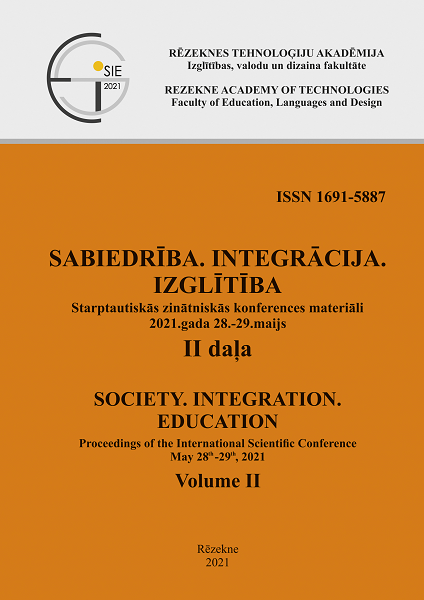THE STYLE FEATURES OF STUDENTS' COGNITIVE ACTIVITY AS THE BASIS FOR FORMATION OF MATHEMATICAL LITERACY
DOI:
https://doi.org/10.17770/sie2021vol2.6413Keywords:
mathematical literacy, components of mathematical content, style features of students’ cognitive activity, ways of representation of information (information coding ways)Abstract
Mathematical literacy is the main indicator of the mathematical development of schoolchildren from different countries. In the concept of the direction "mathematical literacy" of the PISA-2021 study, the key component of the concept of mathematical literacy is mathematical reasoning. The development of this skill, first of all, is determined by the stylistic features of the cognitive activity of students in the study of mathematics. Taking them into account in the development of educational material in mathematics will create optimal conditions for the formation of a key component of mathematical literacy. But there are many stylistic features of cognitive activity. Therefore, to develop optimal conditions, taking into account the style features, it is necessary to answer the question: "Which of the style features of cognitive activity have a stronger effect on the effectiveness of solving mathematical problems and how to implement them in educational mathematical activity." In our study, we identified various ways of implementing style features in educational mathematical material, one of the most significant are ways of presenting (coding) information. With this in mind, an experiment was conducted. We applied analysis of variance to its results. The study showed: 1) in general, it is possible to trace relations between successful mathematical problem solving by students with certain individual styles and the way the selected problem is represented; 2) it is necessary to make further research on students' awareness of their personal cognitive characteristics (style features).
Downloads
References
Anderson, K., Casey, M., Thompson, W., Burrage, M., Pezaris, E., & Kosslyn, S.M. (2008). Performance on Middle School Geometry Problems With Geometry Clues Matched to Three Different Cognitive Styles. Mind, Brain, and Education, 2 (4), 188–197.
Bruner, J. (2010). Beyond the Information Given: Studies in the Psychology of Knowing. London: Routledge.
Сlarke, M. (2011). Framework for building an effective assessment system. Washington: The World Bank.
Dunn, R., Dunn, K., & Price, G. (1989). Learning styles inventory. Lawrence, KS: Price Systems.
Fleming, N. (2007). VARK ‘A review of those who are multimodal’. Retrieved from http://www.vark-learn.com/english/page_content/multimodality.html
Fullan, M. (2011). Vybor lozhnyh dvizhushhih sil dlja reform celostnoj sistemy (per. s angl. A. Pinskoj). Voprosy obrazovanija, 4, 79–105.
Grigorenko, E.L., & Sternberg, R.J. (1995). Thinking styles. In D. H. Saklofske& M. Zeidner (eds.), International handbook of personality and intelligence. New York: Plenum Press. 205-230.
Hartley J. (1998). Learning and studying: A research perspective. London: Routledge.
Holodnaja, M. (2004). Kognitivnye stili. O prirode individual'nogo uma. SPb.: Piter.
Holodnaja, M. (2002). Psihologija intellekta. SPb.: Piter.
Ishkov, A.D., Miloradova, N.G. (2015). Vyjavlenie stilevyh osobennostej vosprijatija, myshlenija i dejatel'nosti s pomoshh'ju oprosnika «SD», Jekonomika i predprinimatel'stvo, 5-1 (58), 432-436.
Jakimanskaja, I. (1979). Razvivajushhee obuchenie: kniga dlja uchitelja. M.: Pedagogika.
Jantan, R. Md. N. M. (2007). Relationship Between Students "Learning Style and Teachers" Teaching Style With Their Mathematic Achievement. Research Report for Sultan Idris EducationUniversity Grant. Tg. Malim: UPSI.
Jantan, R.B. (2014). Relationship between Students’ Cognitive Style (Field-Dependent and Field–Independent Cognitive Styles) with their Mathematic Achievement in Primary School. International Journal of Humanities Social Sciences and Education (IJHSSE), 1(10), 88-93.
Kolb, A., & Kolb, D. (2005). Learning styles and learning spaces: Enhancing experiential learning in higher education. Academy of Management Learning and Education, 4(2), 193–212.
Kruteckij, V. (1998). Psihologija matematicheskih sposobnostej shkol'nikov. M.: Institut prakticheskoj psihologii.
Martins, C., Couto, P., Fernandes, M., Bastos, C., Lobo, C., Faria, L., & Carrapatoso, E. (2011). PCMAT – Mathematics Collaborative Learning Platform. In Pérez, J.B., Corchado, J.M., Moreno, M.N., Julián, V., Mathieu, P., Canada-Bago, J., Ortega, A., Caballero, A.F. (eds.) Highlights in PAAMS. AISC, Springer, Heidelberg Cross Ref Google Scholar, 89, 93–100.
Luver, B. (1995). Obuchenie vsego klassa. M.: Novaja shkola.
Onwumere, O., & Reid, N. (2014). Field Dependency and Performance in Mathematics. European Journal of Educational Research, 3(1), 43-57.
Peterson, K., & Kolb, D. (2018). Vek zhivi - vekuchis. Per. s angl. N.Braginoj. M.: Mann, Ivanov i Ferber.
PISA. (2017). Reading, Mathematics and Science, Preliminary Version, OECD Publishing, Paris. PISA for Development Assessment and Analytical Framework. Retrieved from https://www.oecd.org/pisa/pisa-for-development/PISA-D-Assessment-and-Analytical-Framework-Ebook.pdf.
Ritu, D., & Sugata, M. (1999). Learning Styles and Perceptions of Self. International Education Journal, 1(1). Google Scholar.
Sirotjuk, A. (2001). Obuchenie detej s uchetom psihofiziologii. M.: TC Sfera.


